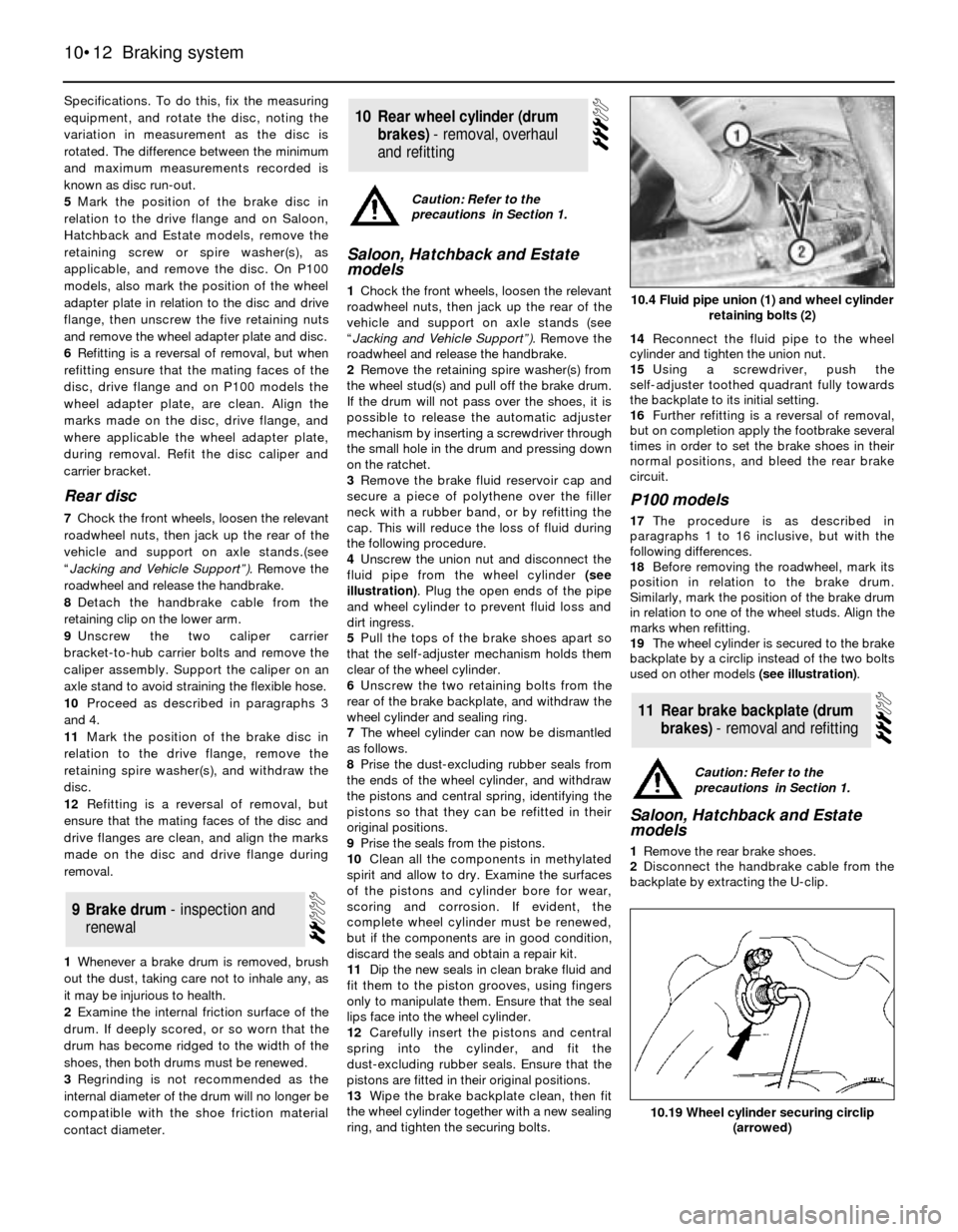width FORD SIERRA 1992 2.G Braking System Workshop Manual
[x] Cancel search | Manufacturer: FORD, Model Year: 1992, Model line: SIERRA, Model: FORD SIERRA 1992 2.GPages: 22, PDF Size: 1.11 MB
Page 12 of 22

Specifications. To do this, fix the measuring
equipment, and rotate the disc, noting the
variation in measurement as the disc is
rotated. The difference between the minimum
and maximum measurements recorded is
known as disc run-out.
5Mark the position of the brake disc in
relation to the drive flange and on Saloon,
Hatchback and Estate models, remove the
retaining screw or spire washer(s), as
applicable, and remove the disc. On P100
models, also mark the position of the wheel
adapter plate in relation to the disc and drive
flange, then unscrew the five retaining nuts
and remove the wheel adapter plate and disc.
6Refitting is a reversal of removal, but when
refitting ensure that the mating faces of the
disc, drive flange and on P100 models the
wheel adapter plate, are clean. Align the
marks made on the disc, drive flange, and
where applicable the wheel adapter plate,
during removal. Refit the disc caliper and
carrier bracket.
Rear disc
7Chock the front wheels, loosen the relevant
roadwheel nuts, then jack up the rear of the
vehicle and support on axle stands.(see
“Jacking and Vehicle Support”).Remove the
roadwheel and release the handbrake.
8Detach the handbrake cable from the
retaining clip on the lower arm.
9Unscrew the two caliper carrier
bracket-to-hub carrier bolts and remove the
caliper assembly. Support the caliper on an
axle stand to avoid straining the flexible hose.
10Proceed as described in paragraphs 3
and 4.
11Mark the position of the brake disc in
relation to the drive flange, remove the
retaining spire washer(s), and withdraw the
disc.
12Refitting is a reversal of removal, but
ensure that the mating faces of the disc and
drive flanges are clean, and align the marks
made on the disc and drive flange during
removal.
1Whenever a brake drum is removed, brush
out the dust, taking care not to inhale any, as
it may be injurious to health.
2Examine the internal friction surface of the
drum. If deeply scored, or so worn that the
drum has become ridged to the width of the
shoes, then both drums must be renewed.
3Regrinding is not recommended as the
internal diameter of the drum will no longer be
compatible with the shoe friction material
contact diameter.
Saloon, Hatchback and Estate
models
1Chock the front wheels, loosen the relevant
roadwheel nuts, then jack up the rear of the
vehicle and support on axle stands (see
“Jacking and Vehicle Support”).Remove the
roadwheel and release the handbrake.
2Remove the retaining spire washer(s) from
the wheel stud(s) and pull off the brake drum.
If the drum will not pass over the shoes, it is
possible to release the automatic adjuster
mechanism by inserting a screwdriver through
the small hole in the drum and pressing down
on the ratchet.
3Remove the brake fluid reservoir cap and
secure a piece of polythene over the filler
neck with a rubber band, or by refitting the
cap. This will reduce the loss of fluid during
the following procedure.
4Unscrew the union nut and disconnect the
fluid pipe from the wheel cylinder (see
illustration). Plug the open ends of the pipe
and wheel cylinder to prevent fluid loss and
dirt ingress.
5Pull the tops of the brake shoes apart so
that the self-adjuster mechanism holds them
clear of the wheel cylinder.
6Unscrew the two retaining bolts from the
rear of the brake backplate, and withdraw the
wheel cylinder and sealing ring.
7The wheel cylinder can now be dismantled
as follows.
8Prise the dust-excluding rubber seals from
the ends of the wheel cylinder, and withdraw
the pistons and central spring, identifying the
pistons so that they can be refitted in their
original positions.
9Prise the seals from the pistons.
10Clean all the components in methylated
spirit and allow to dry. Examine the surfaces
of the pistons and cylinder bore for wear,
scoring and corrosion. If evident, the
complete wheel cylinder must be renewed,
but if the components are in good condition,
discard the seals and obtain a repair kit.
11Dip the new seals in clean brake fluid and
fit them to the piston grooves, using fingers
only to manipulate them. Ensure that the seal
lips face into the wheel cylinder.
12Carefully insert the pistons and central
spring into the cylinder, and fit the
dust-excluding rubber seals. Ensure that the
pistons are fitted in their original positions.
13Wipe the brake backplate clean, then fit
the wheel cylinder together with a new sealing
ring, and tighten the securing bolts.14Reconnect the fluid pipe to the wheel
cylinder and tighten the union nut.
15Using a screwdriver, push the
self-adjuster toothed quadrant fully towards
the backplate to its initial setting.
16Further refitting is a reversal of removal,
but on completion apply the footbrake several
times in order to set the brake shoes in their
normal positions, and bleed the rear brake
circuit.
P100 models
17The procedure is as described in
paragraphs 1 to 16 inclusive, but with the
following differences.
18Before removing the roadwheel, mark its
position in relation to the brake drum.
Similarly, mark the position of the brake drum
in relation to one of the wheel studs. Align the
marks when refitting.
19The wheel cylinder is secured to the brake
backplate by a circlip instead of the two bolts
used on other models (see illustration).
Saloon, Hatchback and Estate
models
1Remove the rear brake shoes.
2Disconnect the handbrake cable from the
backplate by extracting the U-clip.
11Rear brake backplate (drum
brakes) - removal and refitting
10Rear wheel cylinder (drum
brakes) -removal,overhaul
andrefitting
9Brake drum -inspectionand
renewal
10•12Braking system
10.4 Fluid pipe union (1) and wheel cylinder
retaining bolts (2)
10.19 Wheel cylinder securing circlip
(arrowed)
Caution: Refer to the
precautions in Section 1.
Caution: Refer to the
precautions in Section 1.